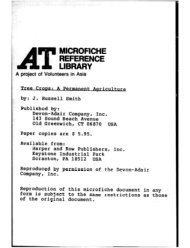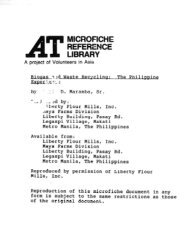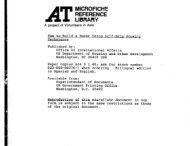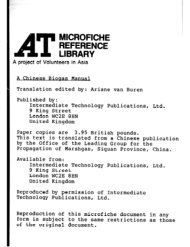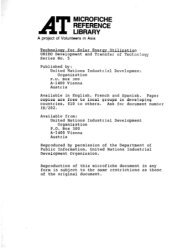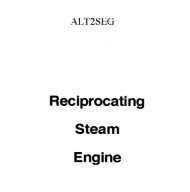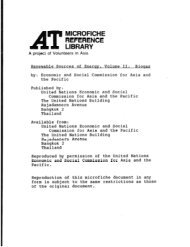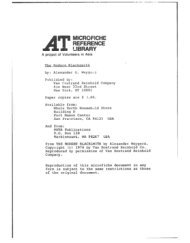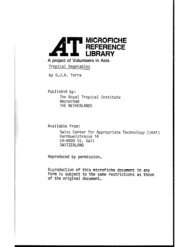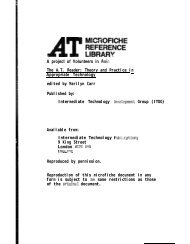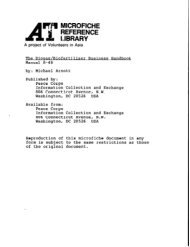Vegetation as an indicator of high wind velocity
Vegetation as an indicator of high wind velocity
Vegetation as an indicator of high wind velocity
Create successful ePaper yourself
Turn your PDF publications into a flip-book with our unique Google optimized e-Paper software.
<strong>an</strong>d root dry weights. A signific<strong>an</strong>t influence to growth <strong>of</strong> trees is<br />
caused by const<strong>an</strong>t <strong>wind</strong> <strong>velocity</strong> is the conclusion <strong>of</strong> the article.<br />
Holroyd, E.W. III, 1970: Prevailing <strong>wind</strong>s on Whiteface Mountain <strong>as</strong><br />
indicated by flag trees., Forest Science, 16, 222-229.<br />
The direction <strong>of</strong> prevailing <strong>wind</strong>s w<strong>as</strong> determined by the study<br />
<strong>of</strong> flag trees on Whiteface Mountain in the New York Adirondack area.<br />
Using both the direction <strong>of</strong> br<strong>an</strong>ch growth <strong>an</strong>d the position <strong>of</strong> the<br />
reaction wood in the trunk tops, a very complex <strong>wind</strong> pattern w<strong>as</strong> found.<br />
Tree-flagging indications <strong>of</strong> the <strong>wind</strong> should be very useful, when combined<br />
with a topographic map, the direction <strong>of</strong> the <strong>wind</strong> wiI.1 show regions <strong>of</strong><br />
rising or subsiding air. Tree-flagging c<strong>an</strong> show are<strong>as</strong> <strong>of</strong> exposure to<br />
strong <strong>wind</strong>s <strong>an</strong>d the drying <strong>as</strong>sociated with them.<br />
Jacobs, M.R., 1936: The effect <strong>of</strong> <strong>wind</strong> on trees. Austral. For. 1: 25-32.<br />
The purpose <strong>of</strong> this article is to discuss the me<strong>an</strong>s <strong>of</strong> preventing<br />
the unnecessary damage which is caused by <strong>wind</strong> on trees <strong>an</strong>d the observa-<br />
tions <strong>of</strong> <strong>wind</strong> damage on trees. When <strong>an</strong>y tree is subjected to a force<br />
which continually acts in one direction such <strong>as</strong> a prevailing <strong>wind</strong>, it puts<br />
on uneven <strong>an</strong>nual rings which ch<strong>an</strong>ge its normal circular cross section to<br />
<strong>an</strong> elliptic with the long axis running down the <strong>wind</strong>. Wind acting on the<br />
<strong>high</strong>er center <strong>of</strong> gravity <strong>of</strong> the crown <strong>of</strong> the <strong>high</strong> crowned tree h<strong>as</strong> a<br />
greater turning moment th<strong>an</strong> in the c<strong>as</strong>e <strong>of</strong> deep crowned trees.<br />
Jacobs, M.R., 1954: The effect <strong>of</strong> <strong>wind</strong> sway on the form <strong>an</strong>d development<br />
<strong>of</strong> Pinus radiata. Austral. J. Bot. 2: 35-51.<br />
Free swaying trees grew more in diameter over the lower part <strong>of</strong><br />
the trunk th<strong>an</strong> stayed trees. The effect <strong>of</strong> sway at the height <strong>of</strong> 4 ft<br />
w<strong>as</strong> greater in a very heavily thinned test area th<strong>an</strong> in a well-stocked<br />
test area. Sway caused incre<strong>as</strong>ed growth <strong>of</strong> roots near the trunk <strong>an</strong>d<br />
incre<strong>as</strong>ed eccentric trunk development along the line <strong>of</strong> main <strong>wind</strong>s. The<br />
height growth <strong>of</strong> stayed trees w<strong>as</strong> little different from that <strong>of</strong> the free<br />
swaying trees, but height/diameter relationships were ch<strong>an</strong>ged. After two<br />
years, trees that had been prevented from swaying were no longer stable<br />
in a normal environment.<br />
Jacobs, M.R., 1939: A study <strong>of</strong> the effect <strong>of</strong> sway on trees. Austral.<br />
Commonw. For. Bur., Bul. No. 26. 17 PP.<br />
This paper describes the experiments designed to determine the<br />
effect <strong>of</strong> sway on tree growth. Two kinds <strong>of</strong> trees, P. radiata <strong>an</strong>d<br />
E. gig<strong>an</strong>tea,were chosen <strong>as</strong> samples, four test plots G-e set up in<br />
different st<strong>an</strong>ds, <strong>an</strong>d these test plots were compared to others acting <strong>as</strong><br />
controls. The whole idea <strong>of</strong> this study w<strong>as</strong> to prevent the tree sway <strong>an</strong>d<br />
this prevention <strong>of</strong> sway caused marked reduction in diameter growth in the<br />
lower part <strong>of</strong> the bole.<br />
- 55 -



